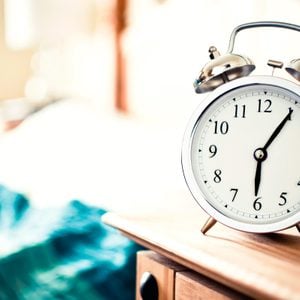Here’s How Long the Best Nap Lasts, a Neuroscientist Says
Updated: May 15, 2024

Nappers, you're going to love this. Plus, here's how to recharge when you can’t get a nice afternoon nap.
Naps don’t just feel amazing to your body—they are amazing for your body. Researchers keep uncovering ways that a midday snooze can benefit your mental and physical health.
One 2019 study published in the peer-reviewed journal Heart found a link between healthy napping habits and a lowered risk of heart disease. And the American Psychological Association (APA) has pointed to how naps can improve memory, learning capacity, immune system function, and mood.
Sara Mednick, PhD, a cognitive neuroscientist at the University of California Irvine and author of 2022 book The Power of the Downstate, spoke with The Healthy @Reader’s Digest to reveal how powerful it is for our bodies to rest and recharge during daytime. Having spent decades researching the effects of sleep, Dr. Mednick suggests napping can be especially effective with some scientific insights in mind.
Bananas for a Good Night’s Sleep? Research Has Found It’s the Perfect Nighttime Snack
How long should I nap?
Dr. Mednick explains that whenever you fall asleep, your body moves through several sleep stages that each play a role in your health. Ideal nap durations are based around this cycle:
- Stage 1: the “dozing off” period as you fall asleep
- Stage 2: your muscles, heart rate, and brain activity begin to slow down
- Stage 3: deep, restorative sleep
- Stage 4: also known as REM (rapid eye movement) sleep, when brain activity picks up, and you’re most likely to dream
The 5-minute nap
“Even a five-minute nap is kind of bizarrely effective,” Dr. Mednick tells us. It’s not necessarily the type of nap she’d recommend—but if it’s all the time you’ve got, research shows that a five-minute power-nap can help give you a bit of a memory boost and decrease drowsiness.
To be specific, during this five-minute period your body starts to shift from stage one to stage two sleep, which gives both your brain activity and nervous system a chance to quiet down.
7 Signs You’re Headed for a Nervous Breakdown
The 20-minute nap
Between 20 and 30 minutes is a napping sweet spot, according to Dr. Mednick, who explains how during this “power nap,” you get enough stage two sleep to switch your body and mind into full relaxation mode. This will leave you feeling more refreshed and less stressed. “What’s interesting is that some signatures of stage two sleep are really critical for memory consolidation,” she adds.
The goal is to avoid moving into stage three—what we think of as “deep”—sleep. While stage three stage is the most restorative, waking up during this phase can often make you feel groggy and present you with difficulty getting on with your day, Dr. Mednick says.
The 60-minute nap
All sleep stages play critical roles in our overall health, but deep sleep is where the magic happens. “You go into a mini hibernation state,” Dr. Mednick says.
Sounds oddly blissful, right? This is a time for your body to repair tissue, fortify your immune system, and recharge its energy stores. Research from 2019 in the Yale Journal of Biology and Medicine also found that deep sleep improves information recall, learning, and general cognitive function. At the same time, a lack of deep sleep is connected with mental health issues like depression, according to an April 2022 review published in Dialogues in Clinical Neuroscience.
So while you don’t want to wake up in the middle of this power-saving mode, you start to move out of stage three sleep around 60 minutes into a nap. (That said, everyone’s sleep cycles are unique, so it may take trial and error to determine the perfect time to set your nap alarm.) Once you round the corner past stage three sleep, REM kicks in, which Dr. Mednick says is “very good for creativity, improving your sensory abilities, and sensory skills.”
REM sleep is also easier to wake up from, helping to prevent disorienting sleep inertia. “And you don’t necessarily need that much REM sleep [during a nap],” Dr. Mednick says. “A little bit can go a long way.”
The 90-minute nap
“If you can get a full 90 minutes, that’s awesome,” says Dr. Mednick. Sure sounds awesome—in fact, the average sleep cycle length is about an hour and a half—and completing a full lap can work wonders for everything from your physical performance to mood, according to research published in the International Journal of Environmental Research and Public Health.
But that’s where you should cap your nap, too. Naps longer than 90 minutes can interfere with your nighttime sleep hygiene and could even impair brain function and memory retention, according to a study published in the Journal of the American Geriatrics Society.
What if I can’t nap?
Some people just don’t like to nap. And not only do they not like them, says Dr. Mednick, but she’s overseen studies that found how certain people don’t actually get much out of napping. “Then I tried to train them to nap and kept testing to see if those naps showed any benefits,” she explains. But at the end of the day, people’s napping preferences stayed the same.
“It turns out that everyone needs to rest, but not everyone necessarily needs to nap,” she says. “The key is really about turning on your restorative system during the day.” Today’s average person keeps the engines revved all day long, maintaining a steady-state of stress in their system. “And this pushes all the body’s restorative needs to the night—and that actually puts a lot of pressure on sleep.”
She explains that the idea is to weave more practices throughout your day that tap into your body’s restorative response. This can include naps, but if napping doesn’t work for you, try:
- Slow, deep breathing exercises, like what you’d do during meditation and yoga. (Here’s How Long You Should Hold a Yoga Pose, Says a 50-Year Expert)
- Lying with your legs up a wall for 10 minutes, giving your heart a break from working against gravity.
- Getting outside to connect with nature.
- Prioritizing intimacy and connecting with the ones you love.
Get The Healthy @Reader’s Digest newsletter for healthy sleep insights delivered on the reg. Follow us on Facebook and Instagram, and keep reading:
- How to Relax: 10 Proven Strategies to Soothe You Right This Minute, from Psychology Experts
- “It’s OK to Slow Down”: The Story Behind TikTok’s Plant-Growing Guru, @Creative_Explained
- Craving Sugar? A Dietitian Says You May Need More of This Surprising Nutrient
- The 10 Best Health Books of 2022: Therapists and Readers Rate the Bestselling Wellness Books So Far This Year
- The 13 Best Walking Shoes, from Podiatrists



















